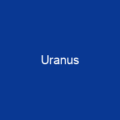Umbriel is a moon of Uranus discovered on October 24, 1851, by William Lassell. Covered by numerous impact craters reaching 210 km in diameter, Umbriel is the second most heavily cratered satellite of UranUS after Oberon. The moon is also designated Uranus II. It orbits Uranus at the distance of about 266,000 km, being the third farthest from the planet among its five major moons.
About Umbriel (moon) in brief

In 2007–2008 a number of such events were observed including two occultations by Umbriel on August 15 and December 8, 2007 as well as of Ariel on August 19, 2007. This would have increased Miranda’s orbital resonance with other Uranus satellites, contributing to the heating and geological activity of that planet. Due to Uranus’s lower oblateness and smaller size relative to its satellites, its moons can escape more easily from a resonance than those of Jupiter or Saturn. After Miranda escaped from this resonance, Umbriel’s eccentricity would have been damped, turning off the source of heat from the heat source. The most prominent surface feature is a ring of bright material on the floor of Wunda crater. This moon probably formed from an accretion disk that surrounded the planet just after its formation. It also serves as a sink of the magnetospheric charged particles, which creates a pronounced dip in energetic particle count near the moon’s orbit as observed by Voyager 2. Both northern and southern poles spend 42 years in complete darkness, and another 42. years in continuous sunlight, with the Sun rising close to the zenith over one of the poles at each solstice. This bombardment may lead to the darkening of the trailing hemispheres.
You want to know more about Umbriel (moon)?
This page is based on the article Umbriel (moon) published in Wikipedia (as of Nov. 06, 2020) and was automatically summarized using artificial intelligence.







